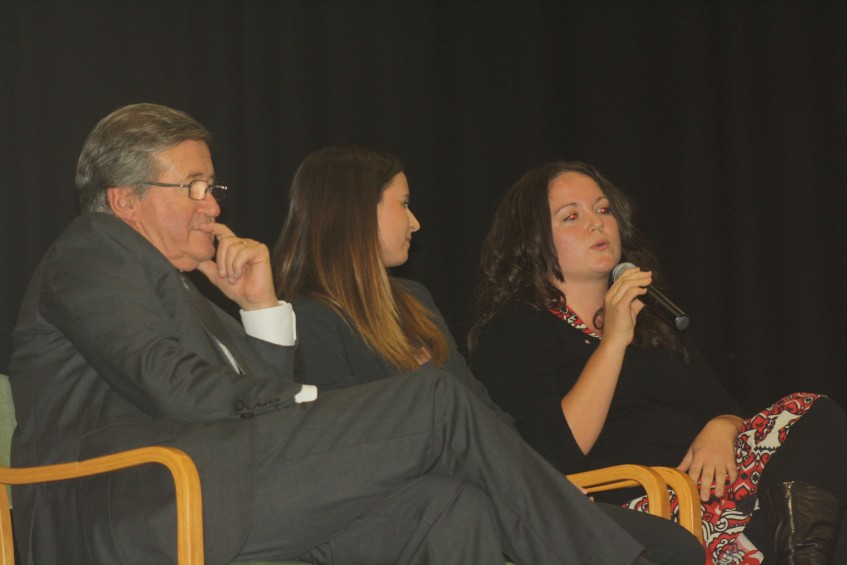Caritas lecture seeks to raise awareness of homelessness

The public lecture, which aims to cover a wide variety of contemporary social justice issues, has become an annual event and first travelled to Perth in 2009. PHOTO: Supplied
By Mark Reidy
There have been multiple studies and great expense injected into the growing social issue of youth homelessness in Australia, according to Chief Justice of Western Australia, the Hon Wayne Martin AC, but the first step to tackling this growing problem may be as simple as providing more accommodation.
Speaking at the Mary Ward Justice Lecture, Chief Justice Martin spoke to more than 130 people at the Loreto Nedlands Performing Arts Centre on 13 May on the topic Homelessness not Hopelessness: Youth Disadvantage in the Criminal Justice System.
The Mary Ward Lecture series was inaugurated in Sydney in 2005 by the then-Loreto Justice, Peace and Integrity of Creation Committee to honour the woman who founded the Loreto Sisters 400 years earlier.
The public lecture, which aims to cover a wide variety of contemporary social justice issues, has become an annual event and first travelled to Perth in 2009.
Sister Janet Palafox IBVM, diocesan co-ordinator for Caritas Australia and one of the organisers of his year’s event, said that this was the first time the lecture had been “100 per cent organised – conceived, born and bred in Perth”.
“As a congregation, we have a particular concern to support women and children, Indigenous people and asylum seekers, and to work for their rights,” Sr Palafox said.
“We felt that holding an annual social justice lecture is one of the ways we could contribute to a conversation and encourage discussion about key issues of concern in our society, its values and what really matters.”
Chief Justice Martin began his presentation acknowledging the myriad of often inter-woven causes behind a person becoming homeless, but concluded with the suggestion that government housing policies may require an inverted approach to those currently being utilised.
He said that environments of sexual, emotional and physical abuse, neglect, violence, mental illness, substance abuse and economic hardship – and usually a combination of these – were the driving forces behind the increasing number of children and young people ending up on the streets and often into a cycle of instability, violence, victimisation, self-harm, crime and the criminal justice system.
Chief Justice Martin believes there needs to be a re-thinking of current policies and programs to deal with the growing numbers falling into systemic gaps and, rather than trying to make those who are homeless deal with these presenting issues - such as addictions and mental illness – he provided an alternative approach which has been successfully adopted in the state of Utah in the United States of America.
In this program, those who have been chronically homeless are provided with their own place to live and then support services are utilised to deal with the specific issues of each person.
He reported that the program had so far resulted in the saving of lives and money as many of those involved were no longer utilising the court system or jail and hospital beds.
During his presentation, Chief Justice Martin confessed to initially painting a “very gloomy picture” of homelessness in Australia, including alarming statistics indicating that, nationally, there were more than 15,000 children under 12 and over 22,000 between the ages of 12 and 24 currently without housing.
He even suggested that these figures were likely to be underestimated due to the difficulty of making contact with those who were intransient or sleeping rough.
Further adding to the depressing outlook was the over-representation of the Aboriginal population which, in Western Australia, constituted a little over three per cent of the population, yet represented 35 per cent of the state’s homeless.
He highlighted the detrimental effects of the recent three-strike public housing policy which has resulted in more than 2,000 Aboriginal children becoming homeless over the past few years.
Referring to numerous studies from both Australia and overseas, Chief Justice Martin also highlighted the intergenerational nature often associated with those who find themselves without safe and stable accommodation, and emphasised the need to break this cycle in order to provide hope for those raised in such situations.
The Chief Justice, however, left the crowd with room for optimism, acknowledging recent policy changes, such as the addressing of family violence, improvements in the Juvenile Justice system and the increased focus on mental health issues as steps in the right direction.
“Happily, I think there are some rays of light,” he assured the audience.
Chief Justice Martin finished his presentation with the example of the Utah model and, while acknowledging that such a policy would require thorough exploration and analysis before being replicated in Western Australia, he was confident that it was an avenue that should be explored.
“In my view, there is a disarmingly simple answer to this question.
“We should provide more housing for the homeless,” he concluded.
